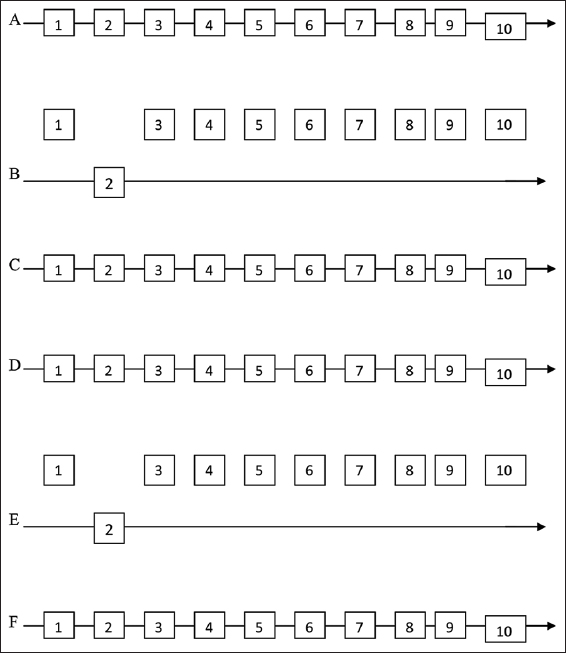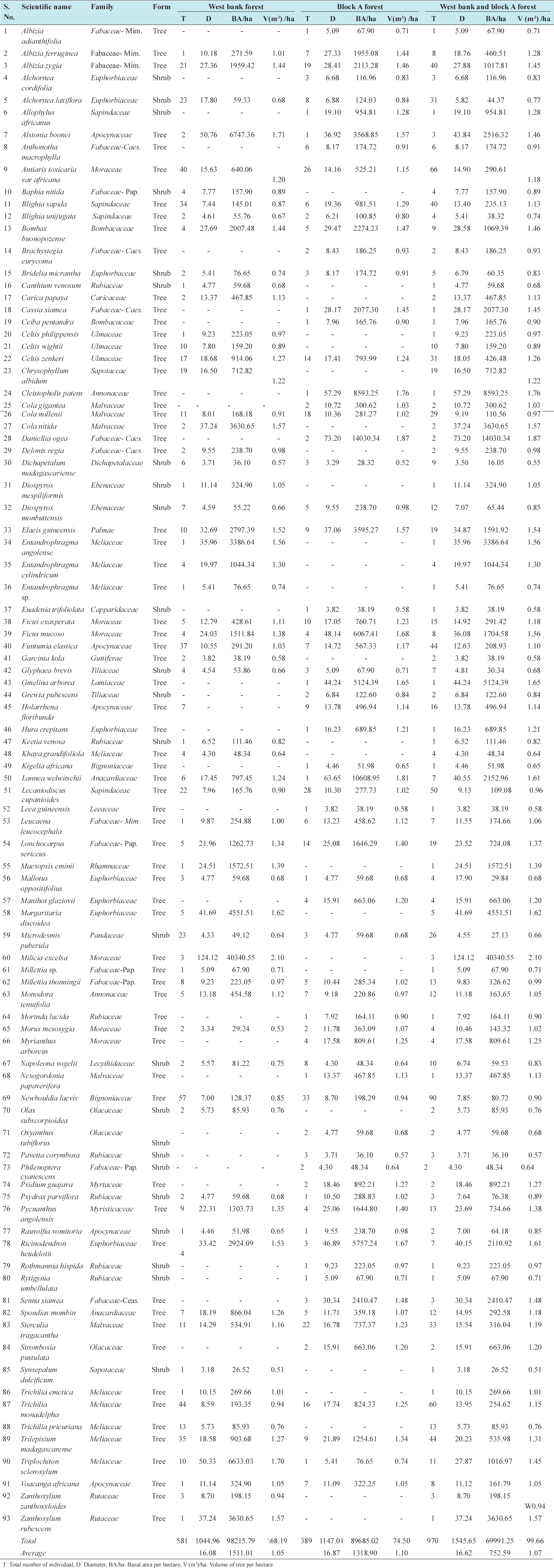1. Clubbe CP, Jhilmit S. A case study of natural forest management in Trinidad. In:Miller FR, Adam KL, editors. Wise Management of Tropical Forests. Oxford:Proceedings of the Oxford Conference on Tropical Forests;1992. 201-9.
2. Makero JS, Malimbwi RE, Eid T, Zahabu E. Models Predicting Above-and Belowground Biomass of Thicket and Associate Tree Species in Itigi Thicket Vegetation of Tanzania. Agric Forest Fisher 2016;5:115-25.
3. Mauya EW, Mugasha WA, Zahabu E, Bollands OM, Eid T. Models for estimation of tree volume in the miombo woodlands of Tanzania. Southern Forests 2014;10:1-11.
4. Mwakalukwa E, Meilby H, Treue T. Volume and aboveground biomass models for dry Miombo woodland in Tanzania. Int J Forest Res 2014;11:1-11.
5. Akindele SO, LeMay VM. Development of tree volume equations for common timber species in the tropical rainforests of Nigeria. Forest Ecol Manage 2006;230:96-104.
6. Shuaibu RB. Developing tree volume equations for Azadirachta indica (Neem Tree) in Katsina state, Nigeria. Gashua J Irrigat Desertific Stud 2015;1:1-2.
7. Ariyo OC. Population structure of woody plants in block a forest of international institute of tropical agriculture (IITA) Ibadan, Oyo State, Nigeria. Sustainable development goals through appropriate forest management strategies. In:Adekunle VA, Ogunsanwo OY, Adewole NA, Oni PI, editors. Proceeding of the 41st Annual National Conference of the Forestry Association of Nigeria held at Abuja, Federal Capital Territory. Nigeria:IITA;2019a. 952-60.
8. Ariyo OC, Oluwalana SA, Akinyemi O, Ariyo MO, Awotide OG. Structure and demographics patterns of woody plant community in IITA forest reserve. Obeche J 2011;29:259-69.
9. Ariyo OC. Socio-economic and Botanic Analysis of West Bank Forest and Block a Forest of IITA, Ibadan, Oyo State, Nigeria. Unpublished Ph.D. Thesis Submitted to the Department of Forestry and Wild life Management. Abeokuta, Ogun State, Nigeria:University of Agriculture;2018. 1-357.
10. Ariyo O, Adedokun MO, Ariyo MO. Determinants of the quantity of non-timber forest products collected from forests of the international institute of tropical agriculture in Ibadan, Nigeria. Asian J Res Agric Forest 2018a;1:1-13.
11. Ariyo OC, Oluwalana SA, Ariyo MO, Aasa OS. Indigenous knowledge of the uses of forest plants found in and around IITA forest reserve in Ibadan, Oyo State, Nigeria. In:Ogunsanwo OY, Akinwale AO, Azeez IO, Adekunle VA, Adewole NA, editors. Sudano-Sahelian Landscape and Renewable Natural Resources Development in Nigeria. Niger:Proceeding of the 37th Annual National Conference of the Forestry Association of Nigeria held in Minna;2014. 304-19.
12. Ariyo OC, Oluwalana SA, Ariyo MO. Profitability analysis of non-timber forest products collected from block a and golf course forests of international institute of tropical agriculture (IITA), Ibadan, Oyo State, Nigeria. Adv Res 2018b;14:1-12.
13. FORMECU. Forest Resources Study, Nigeria. Revised National Report. Vol. 2. Abuja, Nigeria:Prepared for FORMECU by Break and Geomatics International;1999. 224.
14. Tenkouano A, Baiyeri KP. Adoption pattern and yield stability of banana and plantain genotypes grown in contrasting agro-ecology zone in Nigeria. Afr Crop Sci Conf Proc 2007;8:377-84.
15. Ezealor AU. Critical sites for biodiversity conservation in Nigeria. Lagos, Nigeria:Nigeria Conservation Foundation;2002. 110.
16. Ariyo OC. Comparative analyses of diversity and similarity indices of West Bank forest and block a forest of the international institute of tropical agriculture (IITA) Ibadan, Oyo State, Nigeria. Int J Forest Res 2020a;2020:4⇒45.
17. Ariyo OC. Tree stem volume estimation from West Bank forest ecosystem of IITA, Ibadan, Oyo State, Nigeria. J Forest Res Manage 2020b;17:99-110.
18. Ariyo OC. Comparison of woody plants population structure in two distinct forest of international institute of tropical agriculture (IITA) Ibadan, Oyo State, Nigeria. J Forest Res Manage 2019b;16:87-103.
19. Ariyo OC, Oluwalana SA, Faleyimu OI, Ariyo MO. Assessment of vegetation structural diversity and similarity index of IITA forest reserve in Ibadan, Oyo state, Nigeria. Agrosearch J 2012;12:135-57.
20. Lawal A, Adekunle VA. Impact of enrichment planting on biodiversity restoration in degraded forest. In:Popoola L, Ogunsanwo K, Idumah F, editors. Forestry in the Context of the Millennium Development Goals. Proceedings of the 34th Annual Conference of the Forestry Association of Nigeria held in Osogbo, Osun State, Nigeria. Vol. 1. Nigeria:Forestry Association of Nigeria;2011. 558-71.
21. Onefeli AO, Opute OH, Oluwayomi TI. Biodiversity assessment of Okpe Sobo forest reserve, Delta state. In:Popoola L, Ogunsanwo OY, Oni PI, Idumah FO, Akinwole AO, editors. Proceeding of the 36th Annual National Conference of the Forestry Association of Nigeria held at University of Uyo, Akwa-Ibom State Nigeria. Nigeria:University of Uyo;2013. 490-5.
22. Onyekwelu JC, Adekunle AJ, Adeduntan SA. Does tropical rainforest ecosystem possess the ability to recover from severe degradation. In:Popoola L, Mfon P, Oni PI, editors. Sustainable Forest Management in Nigeria:Lessons and Prospects. Proceedings of the 30th Annual Conference of the Forestry Association of Nigeria held in Kaduna, Kaduna State, Nigeria. Nigeria:Forestry Association of Nigeria;2005. 145-63.
23. Aminu SA, Yakubu I. Tree volume equation for Sahelian ecosystem in Northern Nigeria. J Pharmacogn Phytochem 2019;8:2138-40.
24. Akinsanmi FA, Akindele SO. Timber yield assessment in the natural forest area of Oluwa forest reserve, Nigeria. Niger J Forest 2002;32:16-22.






